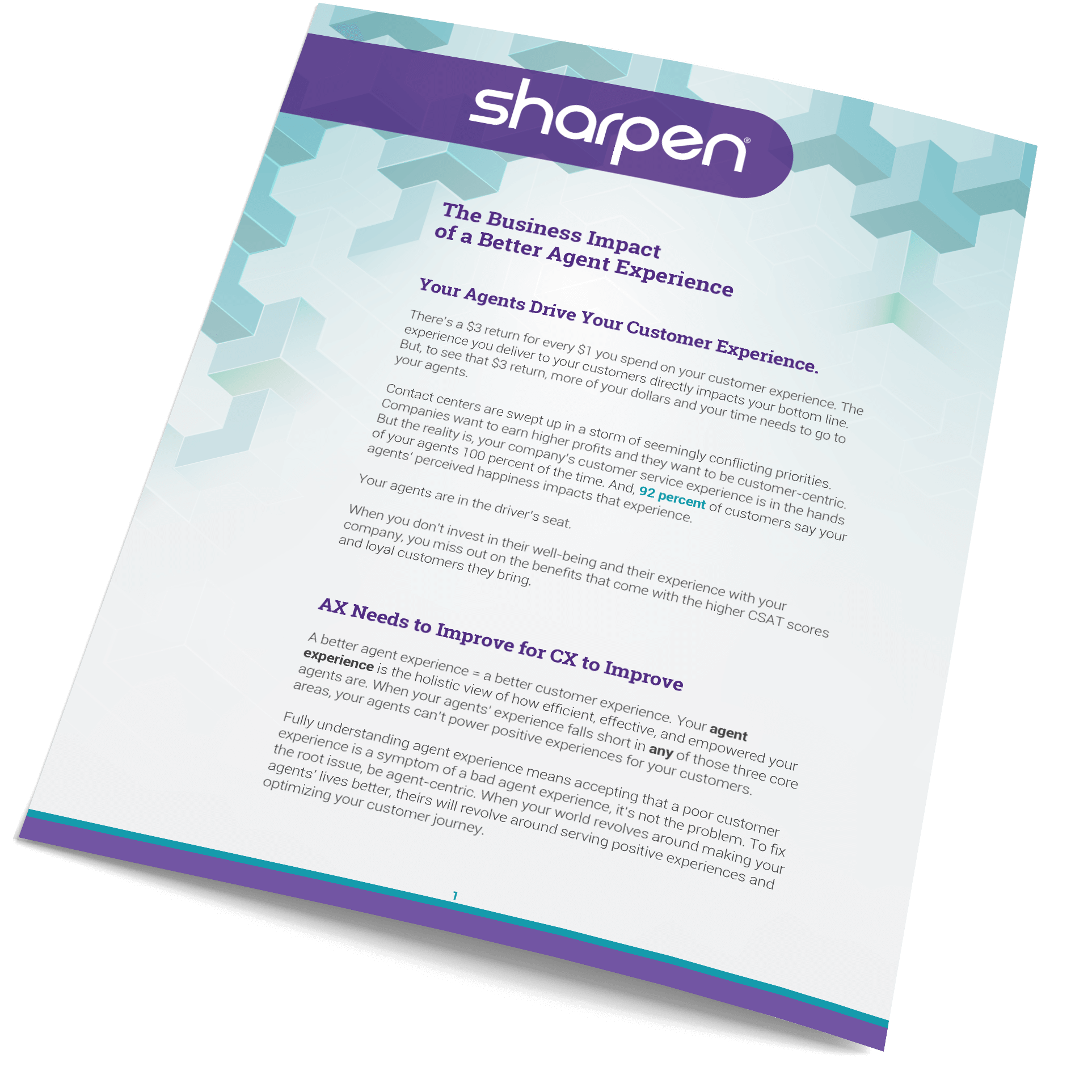
6 Customer Experience Tools & Techniques You Need to Know to Save At-Risk Customers
Improving your customer experience has been crowned the king of the competitive landscape. If you can make your customers happier on their journey with your company, you’ll beat out other top contenders.
But how do you improve your customer experience to save your customers from jumping ship?
Your agents power the ebbs and flows of your customers’ journey. So, it turns out, the better the tools and the training you offer up to your agents, the more satisfied your customers.
[Download Now] A better agent experience benefits your business in these 9 ways
That’s why 70% of all companies plan to ramp up the use of digital technologies to improve business processes, customer engagement and employee productivity by 2022.
With almost all your competition stepping up their CX game, it’s time to pull out all the stops to save your at-risk customers. We broke down a mix of six customer experience techniques and tools to help you avoid customer churn.
Technique #1: Analyze churn to identify patterns pointing to at-risk customers.
Customers who churn provide solid proof points of what not to do in your customer experience. Dig into your churn reports and find the themes and patterns that led to an exit.
Did customers send a webchat message and never get a response? Did they call in five times and never actually reach a live agent? Or, maybe they took their post-interaction customer survey, but their experience didn’t improve after offering feedback.
Look for triggers that made your customers leave, first. Then, look for similar patterns with your existing customers, so you can give them the extra attention they need to stop churn in its tracks.
Tool #1: Better insights and analytics.
The ultimate customer experience tool & tecnique? Map your entire customer journey. Use in-depth insights and analytics to report on every major touchpoint in your customers’ experience. Create customized dashboards to keep a watch on key metrics that impact higher churn, like first call resolution and customer satisfaction.
Once you’ve IDed your at-risk customers, jump into the details for a full view of their interaction history. Then, use the insights you find to seel gaps in your customer journey. If customers call back for help with the same issue five times, you need to focus on your first call resolutions. Ramp up coaching techniques to give your agents the tools to deliver better, more thoughtful resolutions during the customer experience. If customers abandon calls after long hold times, then never reach back out for help, you know you need to get them through to agents faster.
Your data opens the door to a better, more personalized experience for your customers.
Technique #2: Coach agents to deliver proactive service.
Coach your agents to set customers up for success, starting with onboarding. Work with your agents and other departments, like your marketing team, to create onboarding guides and training manuals for your customers, so you always set the right up-front expectations.
If you already have these materials on hand, set a schedule to sit down with internal stakeholders and update them quarterly or annually, whatever makes sense for your business. Freshen them up with the latest information, and send them back to current customers.
But keep in mind, even with the best training materials, some of your customers will still slide into the at-risk territory.
[Read Next] Can proactive customer service work for your call center?
So, find proactive ways to mitigate this risk. Train and develop your agents to be a constant resource for your customers. It could mean serving up extra tools like how-to videos to help with an issue. Or, it could be a follow-up call to check in and give your customer personalized attention. Even when they don’t ask for it. Empower agents to go above and beyond for customers who follow the trends of churners.
Oh, and if you’re a contact center without after-hours agents on deck, offer a self-help route, too. Create a self-service portal to be a 24/7 source of information for your customers who need it.
Tool #2: An omnichannel platform with workforce engagement tools built in.
An omnichannel customer experience gives you more ways to connect customers to answers. And, it gives your agents more ways to see (and use) customer data during interactions.
Pair all that info with better coaching and agents nail down a model of proactive service. One that’s rooted in action instead of stagnation.
With omnichannel tools and techniques, your agents can send an SMS for a quick check-in with a customer to improve their experience. Or they can trigger a follow-up email to go out two weeks after a touchpoint. And when a customer reaches out after hours, bots can serve up relevant materials from your knowledge base to help customers on the fly.
[Read Next] The transformative power of an omnichannel contact center
Plus, some omnichannel platforms (like Sharpen’s) let you train your agents inside the platform. You don’t have to take your agents out of their queue to coach.
Instead, you can serve up lessons right in their queue so they can learn between customer interactions. Remember that interaction that needed a follow-up email? Leave a comment directly on the interaction to remind your agent. Omnichannel lets you and your agents communicate however it makes the most sense.
Technique #3: Improve your customer service with customer and agent feedback.
Direct feedback from your customers gives you the best insight into their journey, so you can fix it before they leave. As you analyze customer patterns and interactions, look out for the at-risk customers who consistently answer post-interaction surveys. Feedback after a negative experience is the best resource to improve your customer experience. Pay mind to your customer surveys and act on the feedback you get.
But don’t neglect your agents’ perspective. Go a step further and analyze your agents’ experience alongside your customers’. Collecting data about your agent experience and their interactions with at-risk customers proves valuable, too. You’ll know if your agents are perpetuating customer problems, or if they’re solving them. Once you know how your agents handle these specific customer cases, you can tailor your feedback and coaching moments to address any concerns you spot.
Tool #3: Customer surveys and agent scorecards.
Customer surveys and frequent customer check-ins help you keep a pulse on your customer experience. Use customer surveys to collect qualitative data from your customers to learn what made their experience or what peeved them enough to tell you about it. Then, do something with the information you collect.
Consider measuring your other important experience metrics, like your customer effort score, too. Some 96% of customers leave companies because when they feel they have to put in too much effort. So, use surveys and customer interviews to find out how your customers really feel about their experience.
Keep in mind: While these techniques & tools for collecting customer experience feedback give you direct insight from customers, the feedback isn’t one-size-fits-all. Survey responses are largely anecdotal. So, pair qualitative feedback with customer interaction and behavioral data for a more complete picture of what’s happening in your contact center.
[Read Next] How to use your data for standout service this year
To improve the service your team gives customers, use agent scorecards in your daily routine. Pick a handful of interactions to review and then grade your agents on those interactions using agent scorecards.
Consistently scoring agents on their interactions helps you find problem areas during interactions. When you point out areas for your agents to improve, and give them the coaching to get better, they won’t send at-risk customers running for the door.
Some customer churn is inevitable. But better data, proactive customer service, and frequent feedback give you avenues to save at-risk customers who teeter on the edge.
We originally published this post on January 22, 2019, and we updated it for new insight on March 11, 2021.


